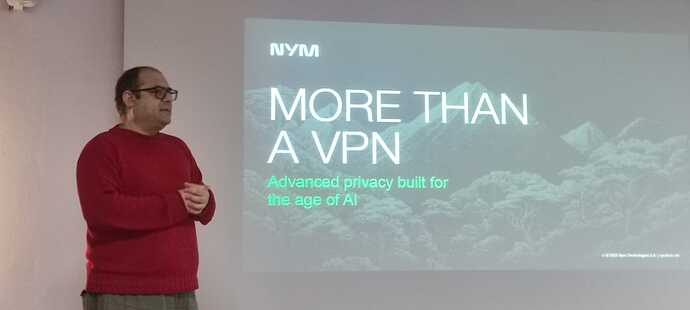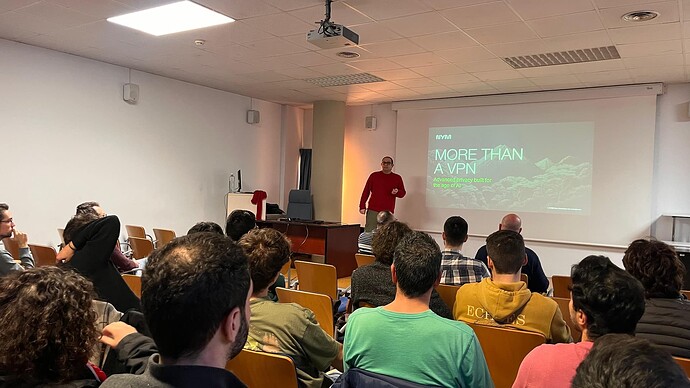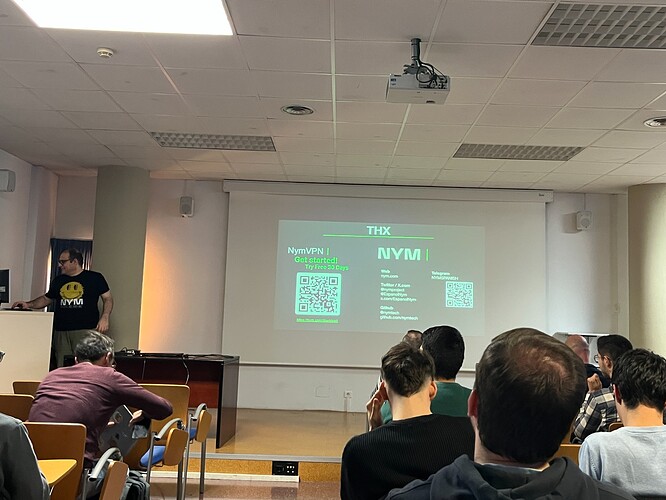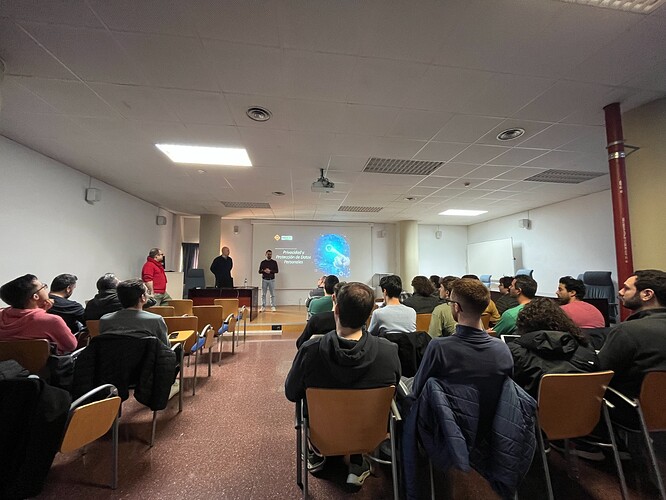Event: CyberCamp-UMA
Dates: January 30, 2025
Place: E.T.S. Telecommunications Engineering at the University of Malaga, Spain
Event Overview
CyberCamp UMA 2025 is a cybersecurity event promoted by the University of Málaga through NICS Lab, with the support of institutions such as the National Cryptologic Center (CCN) and the National Cybersecurity Institute (INCIBE). Its goal is to raise awareness and provide training in cybersecurity through talks, workshops, and activities aimed at both professionals and the general public.
On January 30, I participated in the talk “Cómo proteger mis datos y privacidad en Internet”, where we discussed the use of NYM VPN as an advanced solution to enhance privacy in online browsing.
During the session, we explored current challenges in digital privacy and how tools like NYM VPN can offer anonymization and security for internet traffic. The talk included practical examples and strategies to strengthen personal data protection for both individuals and organizations.
For more information about the event and the full program, you can visit:
- CyberCamp UMA 2025: https://www.nics.uma.es/cybercamp-uma/
- Details of the January 30 event: https://www.nics.uma.es/eventos-pasados-2025/30-enero-como-proteger-mis-datos-y-privacidad-en-internet/
Participants:
The session gathered around 30 participants, including students, professors, institutional representatives, and cybersecurity experts. The event provided a collaborative space where attendees engaged in discussions about privacy challenges and practical solutions like NYM VPN.
This diverse audience enriched the conversation, bringing perspectives from academia, public institutions, and the private sector. Participants actively contributed with questions and insights, making the session an interactive learning experience.
Results of the event
Overall rating of the event:
Average rating: 4.8 out of 5.
Comments: The main limitation was the lack of time due to the large number of questions and discussions about the technology that NYM offers.
There was great interest in understanding how NYM works, with an enthusiastic reception from attendees.
Many participants requested information on how to download and use the technology.
A new session was requested, specifically focused on the application of NYM at different levels or the creation of a workshop to introduce users to becoming node administrators.
Highlights of the event:
The session sparked intense discussions and curiosity among attendees, focusing on several key aspects of NYM technology and its implications for privacy and security.
- Data Obfuscation and Encryption: The most debated topic was how NYM’s mixnet structure obfuscates and encrypts data to ensure anonymity. Participants were particularly interested in the technical architecture that differentiates it from other privacy solutions.
- Project Origin and Funding: Attendees questioned the origins of NYM, its funding sources, and the organizations supporting its development. This led to an insightful discussion on open-source funding models and privacy-focused initiatives.
- NYM Token and Its Role in the Network: Many were eager to understand how the NYM token functions within the ecosystem, its role in incentivizing network operators, and how it integrates with the NYM VPN service.
- The Importance of Anonymization Networks: The discussion expanded to why anonymity matters in today’s digital world, touching on growing threats to privacy and the increasing need for decentralized solutions.
- Practical Applications for Everyday Use: Participants explored how NYM can be integrated into daily activities, adding a layer of security to essential online interactions. They also discussed its potential impact on businesses, activists, and citizens seeking to protect their digital identities.
The high level of engagement and interest highlighted the need for further sessions
Suggestions for improvement:
The presentation was originally planned for 30 minutes, plus 10 minutes for Q&A. However, due to the high volume of questions and discussions, the session extended beyond 40 minutes, with some debates lasting over 10 minutes on specific topics.
While the structure and content of the presentation were well-received, it became evident that a longer session—at least one hour—would be more appropriate for this type of discussion. The complexity of the topic naturally led to further questions and related discussions, making it challenging to cover all key points without rushing through certain sections.
For future sessions, it would be beneficial to:
- Allocate more time (at least 60 minutes) to allow in-depth exploration of NYM’s technology and its implications.
- Consider a dedicated Q&A segment after the main presentation to ensure all questions receive proper attention without disrupting the flow of the talk.
Understanding of the information:
The audience consisted of professionals and advanced students in the field, demonstrating a high level of expertise in cybersecurity and privacy technologies. Rather than questioning the validity of the information presented, attendees focused on evaluating the tool’s effectiveness and its real-world applications.
Discussions were insightful and technically in-depth, with participants analyzing NYM VPN’s structure, encryption methods, and integration possibilities. Their questions were not about understanding the basics, but rather about exploring new ideas and technical uncertainties that emerged as they assimilated the information.
Problems:
Limited Time for Discussion: The session exceeded its scheduled time due to extensive discussions and questions, which led to a rushed conclusion of certain topics.
Diverse Interest Levels: Some participants were more focused on privacy concepts, while others were interested in the technical setup of NYM nodes, making it difficult to cater to all interests in a single session.
Advantages:
Highly Engaged and Knowledgeable Audience: The advanced level of the participants led to a high-quality discussion with valuable technical insights.
Strong Interest in NYM Technology: Many attendees were genuinely interested in using or implementing NYM, with several requesting follow-up sessions or workshops.
Validation from Professionals: The positive reception from cybersecurity experts and academics reinforced the relevance and credibility of the technology.
Potential for Further Collaboration: Institutional representatives showed interest in exploring real-world applications, which could lead to future partnerships or pilot projects.
Conclusions:
The presentation of NYM VPN at CyberCamp UMA 2025 was a resounding success, generating strong interest among a diverse audience of students, professors, institutional representatives, and cybersecurity experts. The high level of engagement, along with the depth of technical discussions, highlighted the relevance and growing demand for privacy-enhancing technologies like NYM.
The event provided an excellent platform to showcase NYM’s capabilities, addressing key concerns such as data obfuscation, encryption, token functionality, and the broader importance of anonymization networks. The overwhelmingly positive response reaffirmed the value of NYM as a cutting-edge solution for privacy and security. Many attendees expressed interest in adopting the technology, requested additional resources, and proposed follow-up sessions, including a hands-on workshop for node administration.
Despite the success, the event also revealed the need for extended time allocations in future presentations, given the complexity of the subject and the volume of questions raised. A dedicated Q&A segment and a longer session duration would enhance future engagements.
Overall, representing NYM at CyberCamp UMA 2025 was an enriching experience, demonstrating the project’s impact and its potential for broader adoption. The enthusiastic reception and professional validation underscore NYM’s importance in the cybersecurity landscape. Moving forward, this engagement could pave the way for further collaborations, institutional partnerships, and deeper community involvement.



